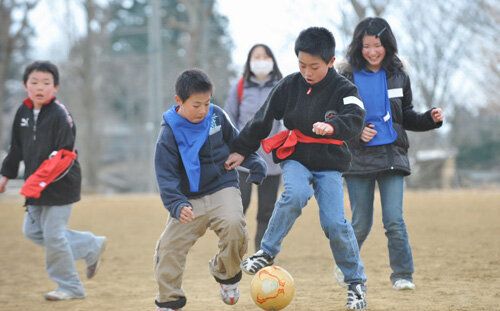
I've heard that a picture is worth a thousand words, but these images held a thousand emotions. National Geographic sent me a link the other day to a photo gallery of soccer equipment made by children in Africa.
I clicked on the photographs of children holding soccer balls crafted from old shopping bags, bits of twine and torn-up strips of old clothing. I marvelled at the variety, each ball as unique as its designer.

Four-year-old Samuel Karangwa shows off his handmade soccer ball in southern Rwanda.
Then I found a picture that kept me riveted to the screen. It was an image of an old, beaten-up pair of soccer shoes, purchased by a boy at a market in Abidjan, Ivory Coast. Across the toes, using paint or magic marker, he had carefully written the name of his favourite soccer team: "Barcelona."
My first thought was one of deep sadness for a boy I'd never met. Someone with big dreams who, if the state of the shoes was any indication, may never get a chance at fulfilling them. But through my sadness came a sense of joy, bubbling up like ginger ale in a party glass. No matter what this child was facing, the shoes hinted that poverty hadn't got the better of his spirit.
Dreams and determination
On my desk here at World Vision, I have a soccer ball just like those photographed by National Geographic. Knowing my fascination with these amazing creations, a colleague made a swap with a little boy in Mali when travelling for work a few years ago.

In Mozambique, Timoteo and his brothers love playing soccer after school and chores.
I've often told my own sons that if there were ever a fire at the office, this ball would be the first thing I'd save. When I'm buried in paperwork and can't seem to feel a connection to the children I've come to World Vision to serve, I hold it in my hands. It's a powerful reminder that children in developing countries are not mere "victims of poverty and injustice." They're boys and girls who are full of dreams, creativity, determination -- and a love of play.
And soccer can be a huge part of living that love. I recall children in Japan laughing their heads off as they played soccer at one of World Vision's child-friendly spaces after an earthquake and tsunami flattened their communities in 2011. I remember visiting a drop-in centre in Cambodia, where World Vision offers soccer as a much-needed break to children working in brick factories. One of the communities with whom we partner in Malawi has introduced a soccer program to lure reluctant children to school (needless to say, enrolment has increased!)

Japanese children who survived the deadly earthquake and tsunami in Japan in 2011 relax in a game of soccer.
A gift from Canada
I replaced my son's old soccer ball last week, at the request of his coach. Although he loved the well-worn orb that had seen him through an exciting summer of play, my adolescent boy was thrilled to have a new one. He took it to school the next day. His friends, seeing its true colours and smooth leather, dropped their electronic devices and took to the field for their first outdoor game of soccer since November.
I asked a colleague who works in Africa what children there feel about a new leather soccer ball, on the rare occasion when one comes their way.
"There's hardly anything that gets kids more excited than a new soccer ball," shared T.J. Grant, regional program manager for Southern Africa. "Soccer is the biggest sport in Africa. Many of the children we serve love the English Premier League, and local teams and matches are a big deal in their communities."
But what about those beautiful creations like the one on my desk? It was hard to accept that children overseas don't marvel at their handiwork in the same way I do.
"While kids certainly 'make do' in amazing ways with the balls they create, a real soccer ball is way better in terms of being able to actually play the game," explains T.J. Grant. "The coolest thing is that they will use these with other kids in the community. A new soccer ball means a huge amount of fun for them."

In a refugee camp in Niger, children who fled their homes in Mali pass the time with soccer. Eleven-year-old Omar Musa (centre) says he's determined to become an international soccer star in the future.
I remembered that it's possible to buy new soccer balls for children overseas through World Vision Gifts. Thinking of what T.J. had said, I made a purchase online before going to bed last night. I'll never meet the child who receives my gift. But seeing my own son head out to soccer practice this weekend -- the highlight of his week -- I'll imagine what joy looks on the day that ball arrives.